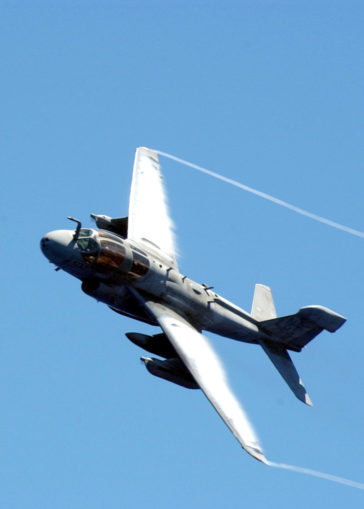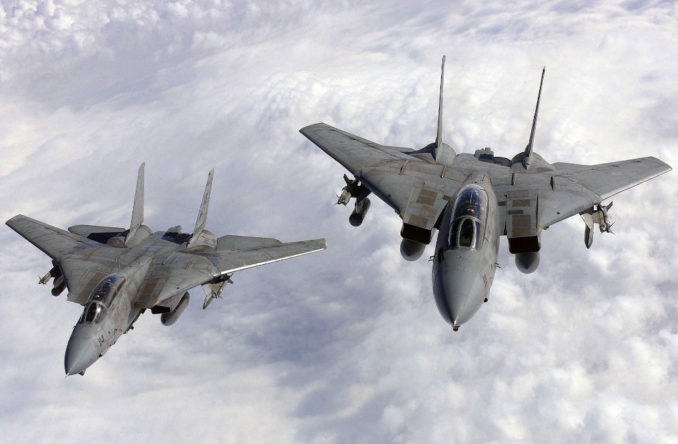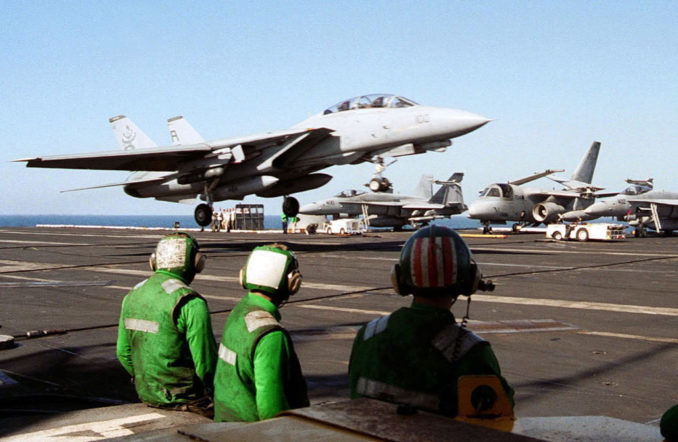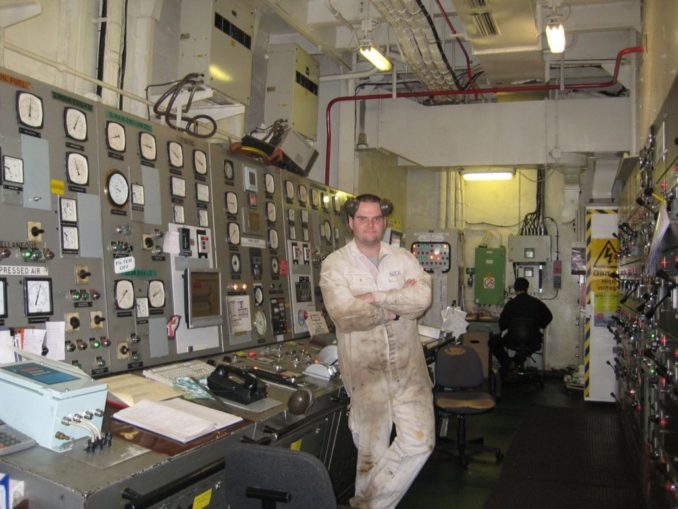
The original uploader was Pkeogh at English Wikipedia. [Public domain], via Wikimedia Commons
Hultgreen was a recently qualified pilot flying the Grumman F-14A Tomcat with VFA-213, the “Black Lions”. USS Abraham Lincoln and its carrier air wing were training off the coast of California working up for a deployment to the Persian Gulf. Hultgreen’s aircraft was performing a landing on the carrier when she found herself to the right of the centreline of the landing area of the flight deck. She applied rudder to yaw the aircraft left and attempt to correct her approach. The F-14A was powered by two General Electric TF30 turbofan engines which were very sensitive to disturbed airflow into the engine. In yawing the aircraft to the left the nose of the Tomcat disrupted the flow of air into the port engine, which caused a compressor stall which resulted in a loss of power from the engine. The Tomcat has rather wide spaced engines and the resulting asymmetric thrust resulted in the aircraft’s nose yawing further to the left. Hultgreen applied full power, including reheat (afterburner) on the starboard engine which greatly exacerbated the effect of the asymmetric thrust given the aircraft’s low speed and high angle of attack as it was approaching to land. At such low speeds and with one engine out and the other in full reheat the aircraft didn’t have the rudder authority to correct the yaw from the huge amounts of asymmetric thrust. The aircraft continued yawing and rolling to the left when the Radar Intercept Officer (RIO, or back seater) initiated a command ejection which would eject both himself and the pilot from the aircraft. His seat ejected first and Hultgreen’s seat 0.4 seconds later. Unfortunately the aircraft had rolled over ninety degrees to the left when Hultgreen’s seat activated and she was fired into the sea and died instantly in the impact. The RIO, Lieutenant Matthew Klemish survived the ejection and was safely recovered from the water. They also recovered the broken remnants of Hultgreen’s flying helmet from the water. Nineteen days later the US Navy recovered her body from the sea bed, still strapped in to the ejection seat.

U.S. Navy photo by Photographer’s Mate 3rd Class Martin S. Fuentes [Public domain], via Wikimedia Commons

SSgt. Suzanne M. Jenkins, USAF [Public domain], via Wikimedia Commons
The board of inquiry concluded the accident was caused by engine failure and that Hultreen’s piloting had contributed to the crash. The F-14A had been in service for twenty years at this point and the engine’s sensitivity to disrupted airflow was well known. The F-14 flight manual warned of the dangers of using excessive rudder inputs at low speeds and it was covered on the training syllabus. Various other interesting pieces of information came out in the aftermath of the crash, including the fact Hultgreen had accumulated four downs during her Tomcat training. A “down” is a major error which is recorded by instructors, and usually two downs was enough to see a student washed out of Tomcat training. Further, it emerged two of Hultgreen’s downs were very similar to her error on the day she was killed.
There was significant media coverage of the incident given Hultgreen was one of the very first female US Navy combat pilots. In an interview with 60 Minutes Lieutenant Jerry Burns, Hultgreen’s Tomcat instructor at VF-124 (the West Coast Tomcat Fleet Replacement Squadron, responsible for training new Tomcat pilots for the Pacific Fleet) stated Hultgreen was a cause for concern during her training and was repeatedly failing to meet the required standards. Not only Hultgreen. Burns was also instructing Lieutenant Carey Lohrenz. Burns stated on camera that both Lohrenz and Hultgreen were at best “marginal” F-14 pilots and that he was convinced one or the other would cause an accident on their first tour. Burns raised these concerns with the commanding officer of VF-124, Commander Tom Sobiek. Burns says that Sobiek told him the four female students on VF-124 at the time would all graduate regardless of their performance. Sobiek denies this claim.

U.S. Navy Photo by Photographer’s Mate Airman Carly J. Cranston. [Public domain], via Wikimedia Commons
Elaine Donnelly of the Centre For Military Readiness, a campaign group which opposes gay and transgender recruits in the military and seeks to limit women to non-combat roles said that Hultgreen’s death was the result of a failed policy of waving women through training to meet a political agenda. Donnelly released leaked documents from Lohrenz’s training indicating her poor performance, including her first attempt at carrier qualifications which yielded among the lowest scores ever recorded by Tomcat student pilots the US Navy. Lohrenz launched a defamation lawsuit against Donnelly. The judge said that Lohrenz was a public figure, being one of the first women to fly combat aircraft with the US Navy, and as such would have to prove Donnelly had malicious intent if the case were to meet the criteria for defamation. The judge ruled that Lohrenz had not proven malicious intent on Donnelly’s part and Lohrenz’s case was thrown out. Lohrenz appealed but the appeal court reached the same conclusion.
The 25th anniversary of the death of Kara Hultgreen has only recently passed. There are many more female fighter pilots in the US military today, but her death still remains controversial.
© Æthelberht 2019
The Goodnight Vienna Audio file
RIP Æthelberht (Nick) who passed away last night, 23rd November 2019 at the age of 38. This is the last article he produced for us. He will be sorely missed by his family and everyone who knew him. A great contributor here and in life having served with the Royal Fleet Auxiliary. Our condolences to his family.




